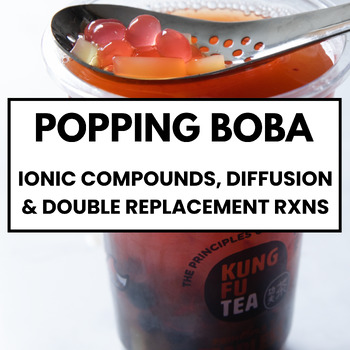Popping Boba: Ionic Compounds & Ions [5-Day Lesson with 5 Labs] gr 8-12
Grade Levels
8th - 12th, Homeschool
Subjects
Resource Type
Standards
NGSSHS-PS1-4
NGSSMS-PS1-2
NGSSHS-PS1-5
NGSSMS-PS1-5
NGSSHS-PS1-2
Formats Included
- Google Drive™ folder
Pages
60+

Made for Google Drive™
This resource can be used by students on Google Drive or Google Classroom. To access this resource, you’ll need to allow TPT to add it to your Google Drive. See our FAQ and Privacy Policy for more information.
Description
Explore popping boba by understanding the role of ions, chemical reactions, and diffusion in making popping boba.
This material supplements our engaging Science Behind video popping boba through the lens of spherification and chemical reactions. Students will learn about ions, ionic compounds, chemical reactions and diffusion.
This Packet Includes:
- 19-page Teacher Lesson Plan with NGSS standards
- 60 Classroom Slides
- 9 Page Textbook Article with Graphics and Illustrations
- 18-page Student Activity Packet that includes Step-by-Step Lab Directions with Student Handouts for 4 Different Progressive Labs (and labs have how to videos!)
NOTE: all of the above materials are linked in the teacher lesson plan at the bottom of the first page.
Total Pages
60+
Answer Key
Included
Teaching Duration
1 Week
Report this resource to TPT
Reported resources will be reviewed by our team. Report this resource to let us know if this resource violates TPT’s content guidelines.
Standards
to see state-specific standards (only available in the US).
NGSSHS-PS1-4
Develop a model to illustrate that the release or absorption of energy from a chemical reaction system depends upon the changes in total bond energy. Emphasis is on the idea that a chemical reaction is a system that affects the energy change. Examples of models could include molecular-level drawings and diagrams of reactions, graphs showing the relative energies of reactants and products, and representations showing energy is conserved. Assessment does not include calculating the total bond energy changes during a chemical reaction from the bond energies of reactants and products.
NGSSMS-PS1-2
Analyze and interpret data on the properties of substances before and after the substances interact to determine if a chemical reaction has occurred. Examples of reactions could include burning sugar or steel wool, fat reacting with sodium hydroxide, and mixing zinc with hydrogen chloride. Assessment is limited to analysis of the following properties: density, melting point, boiling point, solubility, flammability, and odor.
NGSSHS-PS1-5
Apply scientific principles and evidence to provide an explanation about the effects of changing the temperature or concentration of the reacting particles on the rate at which a reaction occurs. Emphasis is on student reasoning that focuses on the number and energy of collisions between molecules. Assessment is limited to simple reactions in which there are only two reactants; evidence from temperature, concentration, and rate data; and qualitative relationships between rate and temperature.
NGSSMS-PS1-5
Develop and use a model to describe how the total number of atoms does not change in a chemical reaction and thus mass is conserved. Emphasis is on law of conservation of matter and on physical models or drawings, including digital forms, that represent atoms. Assessment does not include the use of atomic masses, balancing symbolic equations, or intermolecular forces.
NGSSHS-PS1-2
Construct and revise an explanation for the outcome of a simple chemical reaction based on the outermost electron states of atoms, trends in the periodic table, and knowledge of the patterns of chemical properties. Examples of chemical reactions could include the reaction of sodium and chlorine, of carbon and oxygen, or of carbon and hydrogen. Assessment is limited to chemical reactions involving main group elements and combustion reactions.



